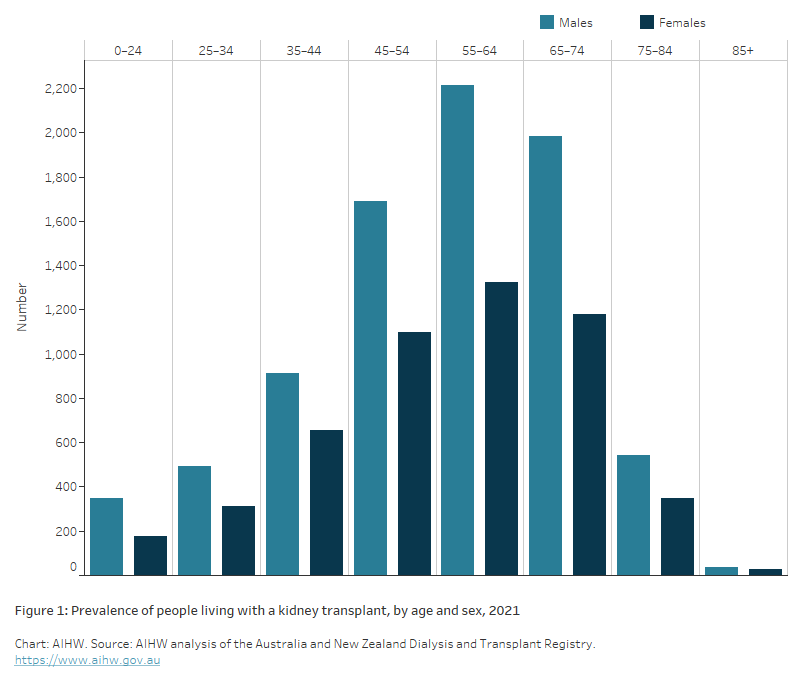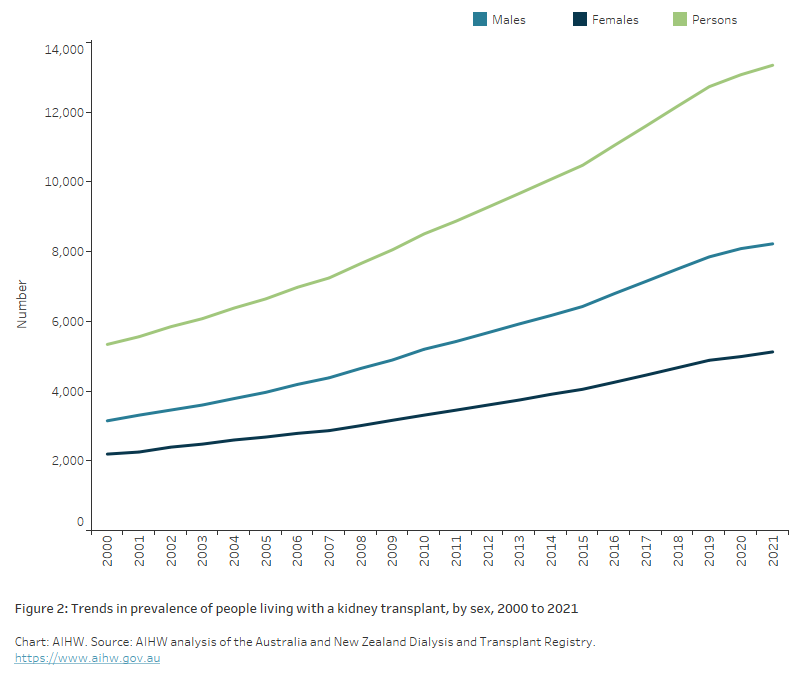Kidney transplantation
Page highlights:
- In 2021, 13,300 people with kidney failure had a functioning kidney transplant.
- In 2021, 857 kidney transplant operations were performed in Australia.
Kidney transplantation is the preferred type of kidney replacement therapy (KRT), as it lowers long-term mortality risk and costs, and increases quality of life (Liem et al. 2008). Following transplantation, care directed towards preventing chronic kidney disease (CKD) is required (KHA 2021).
Successful kidney transplants where recipients are still living with their transplant, regardless of how many years ago they received it, are referred to on this web page as ‘functioning kidney transplants’.
A total of 857 kidney transplant operations were performed in Australia in 2021, with 9 in 10 of these being the first kidney transplant. Of all transplanted kidneys in 2021, 655 (76%) were from deceased donors and 202 (24%) were from living donors (ANZDATA 2022).
Transplanted kidneys can be donated by either deceased or living donors. The number of donated kidneys available for transplantation is insufficient to meet demand. As at 1 May 2023, 1,450 Australians were on the kidney transplant waiting list (ANZOD 2023).
A total of 729 kidney transplants from deceased donors took place in 2022. The COVID-19 pandemic substantially affected activity to do with organ donation and transplantation – 857 kidney transplants from deceased donors took place in 2019, falling to 704 in 2020 (ANZOD 2022). For more information on the impact of COVID-19 on CKD, see Impact of COVID-19.
Variation by age and sex
In 2021, 13,300 people with kidney failure had a functioning kidney transplant (8,200 males and 5,100 females).
The highest number of people with a functioning kidney transplant were in the 55–64 year age group (2,200 men and 1,300 women) (Figure 1). This was followed by the 65–74 year age group (2,000 men and 1,200 women) and then the 45–54 year age group (1,700 men and 1,100 women).
The number of males with a functioning kidney transplant exceeded the number of females in all age groups.
Figure 1: Prevalence of people living with a kidney transplant, by age and sex, 2021
The bar chart shows the number of people living with a kidney transplant in Australia, by age and sex in 2021. Across all ages, more males than females are living with a kidney transplant. Numbers increase by age up to 55-64, followed by those aged 65-74. Around 43% of people living with a kidney transplant are aged under 55.

Trends over time
Over the past 2 decades, the number of people with a functioning kidney transplant has more than doubled, from 5,300 people in 2000 to 13,300 in 2021.
The number of males with a functioning kidney transplant in 2021 was 2.6 times as high as in 2000 (8,200 and 3,100), while the number of females with a functioning kidney transplant was 2.3 times as high (5,100 and 2,200) (Figure 2).
Figure 2: Trends in prevalence of people living with a kidney transplant, by sex, 2000 to 2021
The line chart shows the number of people living with a kidney transplant in Australia, from 2000 to 2021, by sex. In 2000, around 2,200 females and 3,100 males were living with a kidney transplant – in 2021 numbers has risen to 5,100 females and 8,200 males.

ANZDATA (Australia and New Zealand Dialysis and Transplant Registry) (2022) ANZDATA 45th Annual Report 2022, ANZDATA, Adelaide, accessed 16 March 2023.
ANZOD (2022) ANZOD Monthly Report on Deceased Organ Donation in Australia – December 2022, ANZOD, Adelaide, accessed 16 March 2023.
ANZOD (2023) Organ waiting list, ANZOD, Adelaide, accessed 16 March 2023.
KHA (Kidney Health Australia) (2021) An introduction to kidney transplantation, Kidney Health Australia website, Melbourne, accessed 22 February 2022.
Liem YS, Bosch JL and Myriam Hunink MG (2008) Preference-based quality of life of patients on renal replacement therapy: a systematic review and meta-analysis, Value in Health 11:733–741, doi:10.1111/j.1524-4733.2007.00308.x.


